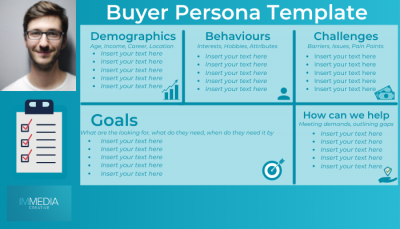Have your leads dried up? Wondering why there’s no engagement with your social posts? Or struggling to break into a new market segment? These are all common problems that will sound very familiar to many a marketing manager. But they’re all problems that can be solved by giving your marketing efforts a greater focus. So, how do you do that? One simple way is to start your planning with a buyer persona.
Buyer persona. Such a weird term. It sounds as if they have their own personal agenda. They do. But the best thing is, you can create that agenda. Whether you have heard of the term before, or are new to it completely, here is a crash course on understanding buyer personas. So, let’s start at the beginning.
What is a buyer persona?
Well firstly, they’re fake. Not in the sense that they don’t work, in fact quite the opposite. They are considered to be a highly effective marketing tool. What we mean by fake is that they are semi-fictional representation of your ideal buyer. Creating this ideal buyer comes from market research and real data about your existing customers.
Buyer personas are a representation of the sort of customers you deal with on a day-to-day basis. Or the type of new buyer you wish to attract. By creating a buyer persona it narrows the gap between 2 crucial things. Your marketing activity and your buyer’s expectations. But how do you create one?
How to create a simple buyer persona
Start with Research
Before you start creating, you need foundations. Research is the cement of any marketing project and is often simple to do. Start by speaking to your sales team. Listen to their feedback based on real life examples. Interview customers and prospects, you could do this with a simple web survey to capture profile insights. Then start looking through contacts database for trends. If you need more information consider talking to customer services/field service teams. Finally, ‘social media listening’ is a great way to uncover unsolicited (and unadulterated) feedback on products and services.
Identify their basic demographic (to help with targeting)
Understanding your buyers’ demographics is an essential building block for the process. Before you launch any new item to the market, you need to figure out your target audience and that normally starts with basic demographics. So with a buyer persona, you do the same.
Start simple, think about who they are:
- Name
- Age
- Interests
- Gender
- Career
Consider their motivations (to help with messaging and product development)
Initially, think about their behaviours, goals, challenges and pain points. Then think about their motivations. We don’t mean what motivates them on a daily basis. I know for some, it’s that perfect summer body. But with August being more showers than sunshine that’s not the sort of motivation that’s considered. Instead think about the motivations they have for buying your product/service. What problem do they have that your product/service is going to solve? What or who is influencing them into buying your product or service?
Find out what channels they use (to help with distribution)
For example, if your ideal buyer spends most of their time on Facebook, you should probably reconsider advertising on Twitter. A persona helps you determine more clearly where to focus your resources, tailor content, and guide product development across your organisation. These are a few suggestions to get you started. Ultimately, you can include whatever you feel is relevant to your existing and aspiring target audience.
Collate your data into a buyer persona template
Once you have your data, collating it into a buyer persona template provides a simple reference tool that can be shared with key stakeholders in the business. This helps to keep everyone on the same page and all efforts targeted towards the same goal. From how your sales team approaches and talks to leads, to how products are developed to meet the needs or your target audience.
You can use our buyer persona template as a guide for how to collate your information.

How customer personas benefit your marketing strategy?
With the right amount of research and time spent on curating these personas, you are increasing your competitive advantage. Along with that, you’ll learn more about any potential customers to help with positioning and messaging to content creation and channel selection. The company can understand user experiences in greater detail and therefore ease product development. By satisfying the needs of each buyer persona at each point of their decision-making journey, you build a stronger bond of trust that results in a choice of you over your competitors.
The benefits of buyer personas are endless. Just remember:
- Buyer Personas shouldn’t be static documents. They can evolve constantly and help your marketing strategy evolve too.
- Buyer Personas can cater to a specific target market via segmentation.
- They help you understand user experiences and help you learn more about any new/current potential buyers.
But if you’re still stuck and need more advice on where to start, feel free to drop us a line.


